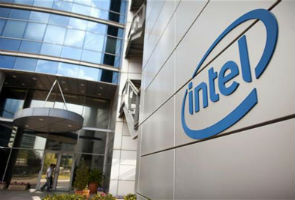Intel's plans for virtual TV come into focus
By Reuters | Updated: 8 June 2012 11:33 IST

Click Here to Add Gadgets360 As A Trusted Source

Advertisement
Intel is counting on facial-recognition technology for targeted ads and a team of veteran entertainment dealmakers to win over reluctant media partners for its new virtual television service.
But so far it's proving a challenge to get the service off the ground, thanks to an unwillingness on the part of major media content providers to let Intel unbundle and license specific networks and shows at a discount to what cable and satellite partners pay.
Intel, the world's largest chipmaker, has kept its strategy to launch a slimmed down cable TV service under wraps as the tech giant risks getting into a completely new line of business.
According to five sources who have been negotiating with Intel for months, the company is emphasizing a set-top box employing Intel technology that can distinguish who is watching, potentially allowing Intel to target advertising.
The set-top box pitched by Intel doesn't identify specific people, but it could provide general data about viewers' gender or whether they're adults or children to help target advertising, two sources said.
Intel's plans put it in the middle of Silicon Valley's battle for the living room. Heavyweights such as Apple , Amazon and Google believe the $100 billion U.S. cable television ecosystem - dominated by major distributors such as Comcast and DirecTV Group and program makers like Walt Disney Co and Time Warner Inc. - is ripe for disruption for reasons ranging from shifting viewer habits to ever-increasing programming costs.
While none of these companies have so far been able to make major inroads, Intel thinks it can build a better set-top box and over-the-top subscription service to deliver TV content to consumers, even though the initiative catapults it into virgin market territory. A successful TV service showcasing Intel technology could be a big step toward making its chips prevalent in more living room devices.
"If they can create a virtual network and it incorporates proprietary Intel technology, they could certainly bring something different to the subscription TV model." said JMP analyst Alex Gauna.
Intel's offering aims to exploit one of the TV industry's major issues: the reliability, or lack thereof, of Nielsen ratings data on audiences. Nielsen has long been the dominant provider of TV ratings, but the accuracy of its data has come under attack by some network programmers, who argue that its polling system of 50,000 homes is antiquated for the digital age.
For its part, Intel claims that the new interactive features in its set-top box would add greater value to TV advertising and help offset reduced revenue from licensing fees for network owners.
"They've told us the technology is going to be so much more interactive with ads that you can make more money. But it's just a little unproven," said one executive who has been involved in the talks.
An Intel representative declined to comment for this story.
Chip features making it easier for Hollywood studios to protect content streamed to computers, as well as tools for detecting faces and analyzing audiences, are examples of current proprietary technology that Intel would like to see widely adopted.
Beyond PCs
While Intel's processors power 80 percent of the world's PCs, its chips have not achieved a significant presence in smartphones, tablets and other interconnected devices. Intel executives say they are eager to make sure its semiconductors play major roles in new markets with big growth potential.
According to a company source, ensuring that its chips become prevalent in home entertainment devices would be the driving reason behind any Internet TV service it launches.
Comcast , for instance, recently announced the gradual rollout of an Intel-based set-top box that customers can control with their smarpthones. Called "X1," the platform will rely on data centers packed with high-end servers -- which typically also use Intel chips.
Intel last year wound down a push to make chips specifically for "smart" TVs after Google TV, which it had backed, failed to make a major splash with consumers.
At the same time, it formed the Intel Media business group with a mandate of promoting digital content on Intel-based platforms.
According to sources, Intel is proposing to media companies a service could include both a bundle of TV channels similar to a normal cable package and an on-demand component.
Enlisting heavyweights
Intel is intent on launching its video service before the end of the year, sources said. Original plans called for it to be launched by November, said one of the sources, but that deadline likely will not be met.
The biggest problem Intel faces is its inability to reach deals with major content providers, which are reluctant to license their networks and TV shows at rates that could undercut their larger established cable and satellite partners.
Intel wants to keep its costs down by licensing smaller packages of TV networks instead of replicating the basic cable TV bundle of more than 100 channels. But network owners won't agree to smaller bundles without being paid a premium for the channels they choose to license.
"Why would I want you to take subscribers away from another distributor at a lower price?," asked the same media executive who spoke with Reuters on condition of anonymity.
To change that mindset, Intel has assembled a team of television industry veterans well-schooled in negotiating distribution deals. Leading the group as head of Intel Media is Erik Huggers, who worked on media at Microsoft before going to the BBC. Huggers enlisted as an adviser Garth Ancier, who most recently served as president for BBC Worldwide America and before that worked at NBC, FOX, and Disney.
In addition to Huggers and Ancier, sources said, two other names prominent in TV circles have emerged as consultants for Intel: entertainment lawyer Ken Ziffren and former MTV executive Nicole Browning.
Browning, who previously negotiated on the other side of the table for MTV, has been handling some of the talks with partners, sources said.
Ziffren built his reputation representing Hollywood talent - he was instrumental in negotiating the deal that returned the "Tonight Show" to Jay Leno. Lesser known is his firm's work negotiating deals for DirecTV's video-on-demand service and carriage agreements for pay-TV network Starz.
But even that quartet of executives may not be enough to resolve an intractable problem, which is that content companies have little incentive to offer their channels to Intel at a discount and Intel is loathe to pay a premium.
"They'd love a better deal but they won't get one," said Needham & Co analyst Laura Martin of Intel. "The industry has always worked on volume discounts."
Underscoring the difficulty insurgent tech companies face in securing content, Microsoft in January indefinitely postponed plans for its own online TV subscription service after deciding that licensing costs were too high, according to people familiar with those discussions.
And therein lies that dilemma that Intel and other insurgent over-the-top providers must tackle before their big plans can be realized.
Copyright Thomson Reuters 2012
But so far it's proving a challenge to get the service off the ground, thanks to an unwillingness on the part of major media content providers to let Intel unbundle and license specific networks and shows at a discount to what cable and satellite partners pay.
Intel, the world's largest chipmaker, has kept its strategy to launch a slimmed down cable TV service under wraps as the tech giant risks getting into a completely new line of business.
According to five sources who have been negotiating with Intel for months, the company is emphasizing a set-top box employing Intel technology that can distinguish who is watching, potentially allowing Intel to target advertising.
The set-top box pitched by Intel doesn't identify specific people, but it could provide general data about viewers' gender or whether they're adults or children to help target advertising, two sources said.
Intel's plans put it in the middle of Silicon Valley's battle for the living room. Heavyweights such as Apple , Amazon and Google believe the $100 billion U.S. cable television ecosystem - dominated by major distributors such as Comcast and DirecTV Group and program makers like Walt Disney Co and Time Warner Inc. - is ripe for disruption for reasons ranging from shifting viewer habits to ever-increasing programming costs.
While none of these companies have so far been able to make major inroads, Intel thinks it can build a better set-top box and over-the-top subscription service to deliver TV content to consumers, even though the initiative catapults it into virgin market territory. A successful TV service showcasing Intel technology could be a big step toward making its chips prevalent in more living room devices.
"If they can create a virtual network and it incorporates proprietary Intel technology, they could certainly bring something different to the subscription TV model." said JMP analyst Alex Gauna.
Intel's offering aims to exploit one of the TV industry's major issues: the reliability, or lack thereof, of Nielsen ratings data on audiences. Nielsen has long been the dominant provider of TV ratings, but the accuracy of its data has come under attack by some network programmers, who argue that its polling system of 50,000 homes is antiquated for the digital age.
For its part, Intel claims that the new interactive features in its set-top box would add greater value to TV advertising and help offset reduced revenue from licensing fees for network owners.
"They've told us the technology is going to be so much more interactive with ads that you can make more money. But it's just a little unproven," said one executive who has been involved in the talks.
An Intel representative declined to comment for this story.
Chip features making it easier for Hollywood studios to protect content streamed to computers, as well as tools for detecting faces and analyzing audiences, are examples of current proprietary technology that Intel would like to see widely adopted.
Beyond PCs
While Intel's processors power 80 percent of the world's PCs, its chips have not achieved a significant presence in smartphones, tablets and other interconnected devices. Intel executives say they are eager to make sure its semiconductors play major roles in new markets with big growth potential.
According to a company source, ensuring that its chips become prevalent in home entertainment devices would be the driving reason behind any Internet TV service it launches.
Comcast , for instance, recently announced the gradual rollout of an Intel-based set-top box that customers can control with their smarpthones. Called "X1," the platform will rely on data centers packed with high-end servers -- which typically also use Intel chips.
Intel last year wound down a push to make chips specifically for "smart" TVs after Google TV, which it had backed, failed to make a major splash with consumers.
At the same time, it formed the Intel Media business group with a mandate of promoting digital content on Intel-based platforms.
According to sources, Intel is proposing to media companies a service could include both a bundle of TV channels similar to a normal cable package and an on-demand component.
Enlisting heavyweights
Intel is intent on launching its video service before the end of the year, sources said. Original plans called for it to be launched by November, said one of the sources, but that deadline likely will not be met.
The biggest problem Intel faces is its inability to reach deals with major content providers, which are reluctant to license their networks and TV shows at rates that could undercut their larger established cable and satellite partners.
Intel wants to keep its costs down by licensing smaller packages of TV networks instead of replicating the basic cable TV bundle of more than 100 channels. But network owners won't agree to smaller bundles without being paid a premium for the channels they choose to license.
"Why would I want you to take subscribers away from another distributor at a lower price?," asked the same media executive who spoke with Reuters on condition of anonymity.
To change that mindset, Intel has assembled a team of television industry veterans well-schooled in negotiating distribution deals. Leading the group as head of Intel Media is Erik Huggers, who worked on media at Microsoft before going to the BBC. Huggers enlisted as an adviser Garth Ancier, who most recently served as president for BBC Worldwide America and before that worked at NBC, FOX, and Disney.
In addition to Huggers and Ancier, sources said, two other names prominent in TV circles have emerged as consultants for Intel: entertainment lawyer Ken Ziffren and former MTV executive Nicole Browning.
Browning, who previously negotiated on the other side of the table for MTV, has been handling some of the talks with partners, sources said.
Ziffren built his reputation representing Hollywood talent - he was instrumental in negotiating the deal that returned the "Tonight Show" to Jay Leno. Lesser known is his firm's work negotiating deals for DirecTV's video-on-demand service and carriage agreements for pay-TV network Starz.
But even that quartet of executives may not be enough to resolve an intractable problem, which is that content companies have little incentive to offer their channels to Intel at a discount and Intel is loathe to pay a premium.
"They'd love a better deal but they won't get one," said Needham & Co analyst Laura Martin of Intel. "The industry has always worked on volume discounts."
Underscoring the difficulty insurgent tech companies face in securing content, Microsoft in January indefinitely postponed plans for its own online TV subscription service after deciding that licensing costs were too high, according to people familiar with those discussions.
And therein lies that dilemma that Intel and other insurgent over-the-top providers must tackle before their big plans can be realized.
Copyright Thomson Reuters 2012
Comments
Get your daily dose of tech news, reviews, and insights, in under 80 characters on Gadgets 360 Turbo. Connect with fellow tech lovers on our Forum. Follow us on X, Facebook, WhatsApp, Threads and Google News for instant updates. Catch all the action on our YouTube channel.
Related Stories
Popular on Gadgets
- Samsung Galaxy Unpacked 2025
- ChatGPT
- Redmi Note 14 Pro+
- iPhone 16
- Apple Vision Pro
- Oneplus 12
- OnePlus Nord CE 3 Lite 5G
- iPhone 13
- Xiaomi 14 Pro
- Oppo Find N3
- Tecno Spark Go (2023)
- Realme V30
- Best Phones Under 25000
- Samsung Galaxy S24 Series
- Cryptocurrency
- iQoo 12
- Samsung Galaxy S24 Ultra
- Giottus
- Samsung Galaxy Z Flip 5
- Apple 'Scary Fast'
- Housefull 5
- GoPro Hero 12 Black Review
- Invincible Season 2
- JioGlass
- HD Ready TV
- Laptop Under 50000
- Smartwatch Under 10000
- Latest Mobile Phones
- Compare Phones
Latest Gadgets
- Huawei Nova 15
- Huawei Nova 15 Pro
- Huawei Nova 15 Ultra
- OnePlus 15R
- Realme Narzo 90x 5G
- Realme Narzo 90 5G
- Vivo S50 Pro Mini
- Vivo S50
- Asus ProArt P16
- MacBook Pro 14-inch (M5, 2025)
- OPPO Pad Air 5
- Huawei MatePad 11.5 (2026)
- Huawei Watch 10th Anniversary Edition
- OnePlus Watch Lite
- Acerpure Nitro Z Series 100-inch QLED TV
- Samsung 43 Inch LED Ultra HD (4K) Smart TV (UA43UE81AFULXL)
- Asus ROG Ally
- Nintendo Switch Lite
- Haier 1.6 Ton 5 Star Inverter Split AC (HSU19G-MZAID5BN-INV)
- Haier 1.6 Ton 5 Star Inverter Split AC (HSU19G-MZAIM5BN-INV)
© Copyright Red Pixels Ventures Limited 2025. All rights reserved.

















